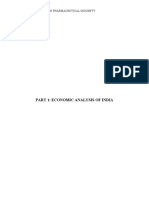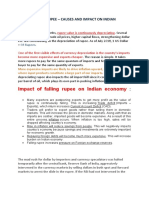Market Outlook VRK100 14062011
Market Outlook VRK100 14062011
Uploaded by
RamaKrishna Vadlamudi, CFACopyright:
Available Formats
Market Outlook VRK100 14062011
Market Outlook VRK100 14062011
Uploaded by
RamaKrishna Vadlamudi, CFACopyright
Available Formats
Share this document
Did you find this document useful?
Is this content inappropriate?
Copyright:
Available Formats
Market Outlook VRK100 14062011
Market Outlook VRK100 14062011
Uploaded by
RamaKrishna Vadlamudi, CFACopyright:
Available Formats
Market Outlook
In a state of flux
Rama Krishna Vadlamudi, HYDERABAD June 14, 2011
With Sensex hovering around 18,250 and Nifty well below 5,500 at the end of June 13, 2011, the Indian stock market looks to be in a lackluster phase. Investors seem to be worried about inflationary concerns, GDP growth deceleration, lack of governance, policy paralysis and political controversies surrounding anti-corruption stirs. However, investors are looking to a good monsoon, some solution to the anti-corruption agitations and some policy reforms. It remains to be seen whether investors expectations will be met. More rate hikes are expected from Reserve Bank of India in this fiscal year.
Inflation
Food inflation proves to be a nemesis for the Government with the latest figures showing a jump in food inflation to 9.01 per cent for the week ended May 28, 2011 compared to previous weeks 8.55 per cent. There is a big mismatch between supply of and demand for food items. Adding to the supply constraints is the rise in demand for food fuelled by rising income levels for the middle income groups in the urban as well as rural areas. Government seems to be having no right solution to control the food inflation in the immediate future. The Government seems to have passed on the buck to the RBI.
RBI rate hikes
Reserve Bank of India has been increasing policy interest rates for the past one year in order to contain inflationary expectations in the economy. It is expected to increase the benchmark repo rate by another 25 basis points or 0.25 per cent when it announces the mid-quarter review of its monetary policy on June 16th. The rate hikes are expected to continue for another two to three quarters. The markets have been bracing themselves for a further rate hike of 50-75 basis points in policy rates in this fiscal year. The banks may absorb some of the rate hikes themselves by compromising on their net interest margins and may pass on only a portion of the rate hikes to borrowers. The banks margins at present are at elevated levels giving them some cushion to absorb the rate hikes.
Rama Krishna Vadlamudi, HYDERABAD
www.scribd.com/vrk100
June 14, 2011
vrk_100@yahoo.co.in
MY BLOG: www.ramakrishnavadlamudi.blogspot.com
Indias GDP Growth
In the last four quarters, Indias GDP growth has come down substantially. After touching a high growth of 9.40 per cent (year-on-year) in the January-March 2010 quarter, the growth rate has come down progressively to 7.80 per cent in the JanuaryMarch 2011 quarter. But the consumption theme seems to be in good shape despite the visible signs of a slowdown in the economy.
FII inflows
After pumping in $ 17.5 billion in 2009 and $ 29.4 billion in Indian equity markets, foreign institutional investors (FIIs) have slowed down their investments in Indian stock market during this calendar year. At $ 85 million of net inflows in this calendar year, their investments have been almost negligible. However, in the first two weeks of this month, they have put in $ 467 million or Rs 2,103 crore in the Indian equity market. The FII appetite for Indian stocks will depend on several global factors, including inflationary concerns in India. The US Federal Reserve (Fed) has been buying bonds worth $ 600 billion. The buying programme, known as Quantitative Easing 2 or QE 2, is coming to an end on June 30th. It is not yet clear whether the Fed will continue or stop its easy money policy after June 30th. If the Fed continues with another round of bond buying or QE 3, this easy money from the US will chase commodities and may push up commodities prices which may be negative for India in general.
Commodities
In the last one month, most of the commodities have come off their inflated levels. Silver has lost 30 per cent from record levels of close to $ 50 (per ounce) levels to $ 35.5 now. Crude oil on Nymex has come down to $ 97 (per barrel) levels with Brent crude hovering around $ 119. But gold prices remain steady at around $ 1,530 per ounce. Gold may continue its dream run for some more time as Europe is going deeper and deeper into a bigger mess following the sovereign crisis affecting Greece, Portugal, Ireland and Spain adversely. The latest news from Europe is that Standard and Poors has cut Greeces rating making it the least creditworthy nation. The ratings agency cut Greeces rating three notches from B to CCC and said the country was likely to default on its debts at least once by 2013. With such anxieties, most of the commodities may come down going forward but gold may remain at elevated levels because of its status as a safe haven asset in times of economic woes. India imports 80 per cent of its crude oil demand making it vulnerable to oil prices. High oil prices increase inflationary expectations in India which in turn adversely impacts Indias growth rate. High oil bill is likely to increase fiscal deficit as the Government is unable to pass on fully the rise in international oil prices to consumers. Diesel, LPG and Kerosene are heavily subsidized in India. Page 2 of 3
Rama Krishna Vadlamudi, HYDERABAD
www.scribd.com/vrk100
June 14, 2011
vrk_100@yahoo.co.in
MY BLOG: www.ramakrishnavadlamudi.blogspot.com
With problems persisting in the Middle East, low inventories and lack of spare capacity, crude oil prices may not come down significantly in the near future unless something dramatic happens in OPEC (the body of oil exporters). The US dollar index (against a basket of six major currencies, like, Euro, Yen and Pound Sterling) is around 74.5. The US dollar has been weakening against these major currencies in the last six months. However, in the last one week, it has shown some resilience and the index has moved up from lows of 72.5 to the present 74.5. The dollars overall weakness is pushing up commodities prices to some extent.
Global factors
The Dow Jones is at around 11,950 well below 12,000 after reaching a high of 12,800 recently. The S & P 500 is hovering around 1,270 after reaching a high of 1,360. The US indices have been in a bullish range in the last six to eight months. However, the Asian indices have been mostly in bearish territory. The Shanghai Composite (China) is at a low level of 2,700. The Hang Seng (Hong Kong) index is at 22,500 and Nikkei 225 is at a weak level of 9,400. The FTSE 100 and DAX indices are much stronger at 5,770 and 7,080 respectively. China is going through its own problems. The non performing assets of Chinese banks are expected to go up significantly in the next one year. The central bank there has been increasing interest rates to tackle inflation. China wants its growth rates to slow down a bit to avoid any hard landing. There are concerns of overinvestment and overcapacity in Chinas manufacturing sector. Following the global financial crisis of 2007/2008, China had pumped in huge amounts into its infrastructure and manufacturing sector.
Summary
The Indian Government and the RBI have to tackle inflation both from the fiscal and monetary angles. Some economists have suggested that allowing Indian rupee to appreciate against the US dollar may help in containing inflation in India. The data from RBI indicates that it has not been intervening in the foreign exchange market. The Government and RBI have to take both immediate and long-term measures to tackle inflation head on. However, the Government seems to be in some sort of a gridlock embroiling itself in controversies about how to tackle corruption monster. The general impression is that the Government may not be able to push the economic reforms forward in such a situation. The disinvestment programme seems to be in a limbo. The markets have noticed this policy drift and have been expecting further slide in stock indices. Investors need to be cautious at this point of time. As such, it is not a bad idea to hold some cash and wait for a correction and start buying Indian stocks at Sensex levels of between 16,500 and 17,500.
Page 3 of 3
You might also like
- About Info Record Update Indicator (569885)Document6 pagesAbout Info Record Update Indicator (569885)Pilla Satish KumarNo ratings yet
- RBG Financial News LetterDocument2 pagesRBG Financial News Lettermarketing2871No ratings yet
- Rama Krishna Vadlamudi, HYDERABAD July 11, 2011: What Investors IgnoredDocument4 pagesRama Krishna Vadlamudi, HYDERABAD July 11, 2011: What Investors IgnoredRamaKrishna Vadlamudi, CFANo ratings yet
- India 2013 Picks - StocksDocument71 pagesIndia 2013 Picks - StocksganeshtskNo ratings yet
- 21MAYDocument3 pages21MAYritudahiya1389No ratings yet
- Market Outlook Market Outlook: Dealer's DiaryDocument6 pagesMarket Outlook Market Outlook: Dealer's DiaryAngel BrokingNo ratings yet
- Economic Environment of Business: Group 1Document4 pagesEconomic Environment of Business: Group 1Darshan SankheNo ratings yet
- Week Ended September 21, 2012: Icici Amc Idfc Amc Icici BankDocument4 pagesWeek Ended September 21, 2012: Icici Amc Idfc Amc Icici BankBonthala BadrNo ratings yet
- Artcles On Rupee DevaluationDocument36 pagesArtcles On Rupee Devaluationolympia kurmiNo ratings yet
- Awm House View - q3 Fy25Document35 pagesAwm House View - q3 Fy25saurav8912sharmaNo ratings yet
- EIC Project Report On Pharmaceutical IndustryDocument52 pagesEIC Project Report On Pharmaceutical IndustrykalpeshsNo ratings yet
- American Stimulus PackageDocument2 pagesAmerican Stimulus PackagePriya SharmaNo ratings yet
- We Expect Liquidity To Be Tight Till December, at Least. - J P MorganDocument5 pagesWe Expect Liquidity To Be Tight Till December, at Least. - J P MorganAlpesh PatelNo ratings yet
- Centrum Wealth - India Investment Strategy - 24 August 2013Document61 pagesCentrum Wealth - India Investment Strategy - 24 August 2013Davuluri OmprakashNo ratings yet
- Falling Indian RupeeDocument3 pagesFalling Indian RupeeAutonomo UsNo ratings yet
- India Struggles To Avoid Curse of StagflationDocument8 pagesIndia Struggles To Avoid Curse of StagflationSohil KisanNo ratings yet
- Free Falling:: How Low Will The Rupee Go?Document56 pagesFree Falling:: How Low Will The Rupee Go?psatyasrinivasNo ratings yet
- Daily: Economic PerspectiveDocument3 pagesDaily: Economic PerspectiveDEEPAK KUMAR MALLICKNo ratings yet
- Weekly Macro Perspectives: June 4, 2011Document5 pagesWeekly Macro Perspectives: June 4, 2011Abhijit NagendraNo ratings yet
- Rupee DepreciationDocument6 pagesRupee DepreciationRahul ChaturvediNo ratings yet
- Retail Research: Weekly Debt ReportDocument11 pagesRetail Research: Weekly Debt ReportGauriGanNo ratings yet
- Monetary Policy and Role of Banks: February 2015Document7 pagesMonetary Policy and Role of Banks: February 2015anik24No ratings yet
- Invesco Factsheet July 2023Document56 pagesInvesco Factsheet July 2023Akhilesh ksNo ratings yet
- Weekly Mutual Fund and Debt Report: Retail ResearchDocument15 pagesWeekly Mutual Fund and Debt Report: Retail ResearchGauriGanNo ratings yet
- Ficc Times // /: The Week Gone by and The Week AheadDocument5 pagesFicc Times // /: The Week Gone by and The Week Aheadr_squareNo ratings yet
- The Recent Depreciation of The INR Against The USD: An Analysis of Currency FluctuationsDocument4 pagesThe Recent Depreciation of The INR Against The USD: An Analysis of Currency FluctuationsRaeesudheenNo ratings yet
- The Ageing RupeeDocument2 pagesThe Ageing RupeeAniket PallavNo ratings yet
- India Vs Major Emerging EconomiesDocument1 pageIndia Vs Major Emerging EconomiesNaveen PalNo ratings yet
- India Markets BriefDocument7 pagesIndia Markets BriefKalapala SandeepNo ratings yet
- Depreciating Indian Rupee ReasonsDocument3 pagesDepreciating Indian Rupee ReasonsVikas KalaniNo ratings yet
- India Economic Outlook - Deloitte InsightsDocument20 pagesIndia Economic Outlook - Deloitte InsightsAakash MalhotraNo ratings yet
- Eadlines: Saturday, September 24, 2011Document16 pagesEadlines: Saturday, September 24, 2011Seema GusainNo ratings yet
- Indias Economic WoesDocument3 pagesIndias Economic WoesresfreakNo ratings yet
- LinkDocument24 pagesLinkDhileepan KumarasamyNo ratings yet
- Devaluation of MoneyDocument5 pagesDevaluation of MoneyDynamic LevelsNo ratings yet
- SEB Report: Asian Recovery - Please Hold The LineDocument9 pagesSEB Report: Asian Recovery - Please Hold The LineSEB GroupNo ratings yet
- Business Line JulyDocument7 pagesBusiness Line JulyRaj KishoreNo ratings yet
- LinkDocument12 pagesLinkManali KambleNo ratings yet
- IA MacroeconomicsDocument6 pagesIA MacroeconomicsMichelle Elie T.No ratings yet
- Hallenges For The Indian Economy in 2017Document7 pagesHallenges For The Indian Economy in 2017Asrar SheikhNo ratings yet
- Speak of The Week Aug 10-2012Document3 pagesSpeak of The Week Aug 10-2012Bonthala BadrNo ratings yet
- Senior Analyst January 2012Document51 pagesSenior Analyst January 2012Arpan BhagatNo ratings yet
- Ndia Is The 11th Largest Economy in The World by Nominal GDP and 4th Largest by Purchasing Power ParityDocument3 pagesNdia Is The 11th Largest Economy in The World by Nominal GDP and 4th Largest by Purchasing Power ParityShubhangi PanpatilNo ratings yet
- I-Direct - Monthly Investment StrategyDocument11 pagesI-Direct - Monthly Investment StrategyRajesh KatareNo ratings yet
- Ficc Times: The Week Gone by and The Week AheadDocument5 pagesFicc Times: The Week Gone by and The Week Aheadr_squareNo ratings yet
- News Letter As On 10-Dec FinalDocument10 pagesNews Letter As On 10-Dec FinalkalpanavermaNo ratings yet
- Restoring High Growth: Guest ColumnDocument2 pagesRestoring High Growth: Guest Column47403768No ratings yet
- India ForecastDocument10 pagesIndia Forecastmalikrocks3436No ratings yet
- Best Efforts By: Pranav Singla Sahil Gupta Xi-CDocument17 pagesBest Efforts By: Pranav Singla Sahil Gupta Xi-CFareen S FareenNo ratings yet
- Niveshak Niveshak: Financial Woes of India'S Rising SunDocument24 pagesNiveshak Niveshak: Financial Woes of India'S Rising SunNiveshak - The InvestorNo ratings yet
- Market Outlook 2024 - Kotak SecuritiesDocument36 pagesMarket Outlook 2024 - Kotak Securitiesgg1512100% (1)
- Effect of Russia Ukraine War On Indian EconomyDocument6 pagesEffect of Russia Ukraine War On Indian EconomySudipto Roy0% (1)
- Appreciation of Indian RupeeDocument16 pagesAppreciation of Indian RupeeMukesh ChauhanNo ratings yet
- Small could be better now: +1 σ Avg PE -1 σDocument3 pagesSmall could be better now: +1 σ Avg PE -1 σChandan AgarwalNo ratings yet
- WeeklyDocument15 pagesWeeklySeema GusainNo ratings yet
- FICC Times 22 Mar 2013Document6 pagesFICC Times 22 Mar 2013r_squareNo ratings yet
- National Geographic September 1989 IssueDocument144 pagesNational Geographic September 1989 IssueRamaKrishna Vadlamudi, CFANo ratings yet
- LT Foods Company Analysis 24apr2022Document8 pagesLT Foods Company Analysis 24apr2022RamaKrishna Vadlamudi, CFANo ratings yet
- How BSE Indices Fared-VRK100-31Mar14Document2 pagesHow BSE Indices Fared-VRK100-31Mar14RamaKrishna Vadlamudi, CFANo ratings yet
- CPSE ETF Avoid Investing-VRK100-19Mar2014Document5 pagesCPSE ETF Avoid Investing-VRK100-19Mar2014RamaKrishna Vadlamudi, CFANo ratings yet
- What Is Asset Allocation-VRK100-14Oct2012Document3 pagesWhat Is Asset Allocation-VRK100-14Oct2012RamaKrishna Vadlamudi, CFANo ratings yet
- Decoding US Govt Shutdown-VRK100-27Sep13Document4 pagesDecoding US Govt Shutdown-VRK100-27Sep13RamaKrishna Vadlamudi, CFANo ratings yet
- What To Expect From Raghuram Rajan?-VRK100-04Sep13Document3 pagesWhat To Expect From Raghuram Rajan?-VRK100-04Sep13RamaKrishna Vadlamudi, CFANo ratings yet
- Indian Economy's Strengths & Weaknesses-VRK100-01Sep2013Document2 pagesIndian Economy's Strengths & Weaknesses-VRK100-01Sep2013RamaKrishna Vadlamudi, CFANo ratings yet
- Short Report-Swelect Energy Systems VRK100-04Aug2013Document2 pagesShort Report-Swelect Energy Systems VRK100-04Aug2013RamaKrishna Vadlamudi, CFANo ratings yet
- LAF Repo Rate-The Single Policy Rate-VRK100-23Jul2013Document4 pagesLAF Repo Rate-The Single Policy Rate-VRK100-23Jul2013RamaKrishna Vadlamudi, CFANo ratings yet
- ParisonDocument35 pagesParisonMurann EzineNo ratings yet
- Routes of Drug AdministrationDocument32 pagesRoutes of Drug AdministrationDawn WRein Legaspi100% (1)
- Scroll - WikipediaDocument4 pagesScroll - WikipediaAmogh TalpallikarNo ratings yet
- It8570eDocument417 pagesIt8570eal_adniNo ratings yet
- Assembly Language Programming - CS401 Power Point Slides Lecture 03Document24 pagesAssembly Language Programming - CS401 Power Point Slides Lecture 03ارسلان علیNo ratings yet
- Activity Sheets For SDGsDocument2 pagesActivity Sheets For SDGsJay P. Ybañez0% (1)
- Literature Study: Crosswinds AppartmentsDocument14 pagesLiterature Study: Crosswinds AppartmentsPrakathish waranNo ratings yet
- CT 144365 PDFDocument2 pagesCT 144365 PDFhecazorlaNo ratings yet
- CV Arjun PDFDocument2 pagesCV Arjun PDFRana BiswasNo ratings yet
- Cabinet Ministry of HaryanaDocument4 pagesCabinet Ministry of HaryanaSamyak GoyalNo ratings yet
- PTERIDOPHYTESDocument13 pagesPTERIDOPHYTESaigilNo ratings yet
- Mycology Micro D&R AgamDocument46 pagesMycology Micro D&R AgamNirosha Arul100% (1)
- ITT300 Assignment 1 - Basic Network CommandsDocument3 pagesITT300 Assignment 1 - Basic Network CommandsIsyraf AzriNo ratings yet
- CLS ENG 23 24 XI Phy Target 2 Level 1 Chapter 3Document43 pagesCLS ENG 23 24 XI Phy Target 2 Level 1 Chapter 38311.harshitNo ratings yet
- BWR Nuclear SystemsDocument25 pagesBWR Nuclear SystemsLaavaniyaa AnanthanNo ratings yet
- Elder XornDocument1 pageElder XornGennifer BoneNo ratings yet
- Physical Activity and Weight Gain Prevention: I-Min Lee Luc Djoussé Howard D. Sesso Et AlDocument8 pagesPhysical Activity and Weight Gain Prevention: I-Min Lee Luc Djoussé Howard D. Sesso Et Alkat_b7No ratings yet
- Starbucks Fiscal 2021 Annual ReportDocument1 pageStarbucks Fiscal 2021 Annual ReportLeslie GuillermoNo ratings yet
- IC Engine PPT ch-1Document73 pagesIC Engine PPT ch-1ashenafi tesfaye100% (1)
- Atari 2600 Programming For Newbies by Andrew Davie: AtariageDocument172 pagesAtari 2600 Programming For Newbies by Andrew Davie: AtariageArkinuxNo ratings yet
- Datasheet For Steel Grades Carbon Steel Swrch6ADocument3 pagesDatasheet For Steel Grades Carbon Steel Swrch6AzaxaxazNo ratings yet
- ABMA Boiler Maintenance ScheduleDocument1 pageABMA Boiler Maintenance Schedulesthefany whiteNo ratings yet
- Measuring Sources of Brand Equity: Capturing The Consumer MindsetDocument32 pagesMeasuring Sources of Brand Equity: Capturing The Consumer MindsetNavdeep MayallNo ratings yet
- Amardeep Office ChairDocument37 pagesAmardeep Office ChairsONDY mONDYNo ratings yet
- Bio Medical Waste ManagementDocument15 pagesBio Medical Waste ManagementNavpreet Kaur100% (5)
- Tigweldarc Alloys: Certification of TestsDocument1 pageTigweldarc Alloys: Certification of TestsArunNo ratings yet
- HMAC Algorithm Stands For Hashed or Hash Based Message Authentication CodeDocument4 pagesHMAC Algorithm Stands For Hashed or Hash Based Message Authentication CodeMarianinu antonyNo ratings yet
- Frances Leah Sapla - OKDocument3 pagesFrances Leah Sapla - OKKelvin Jay Sebastian SaplaNo ratings yet
- LabDocument2 pagesLabChief KyleNo ratings yet



































































































